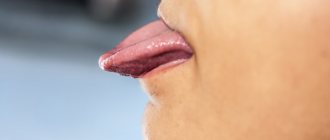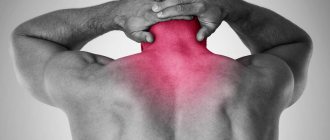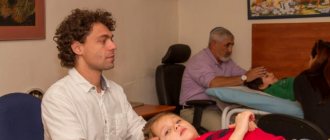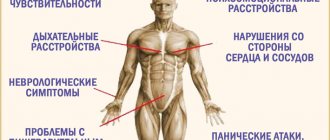All articles by the author
Author of the article: Koneva Elena Vladislavovna
Practicing Gestalt therapist (psychology). Work experience more than 15 years.
Pseudobulbar syndrome is a neurological symptom complex that is caused by various reasons. It is not widespread, but can be diagnosed in both children and adults. Clinical manifestations are similar to bulbar syndrome, but differ from it in the level of damage to nervous structures and prognosis.
What is bulbar syndrome?
Bulbar syndrome is a neuropsychiatric disorder that occurs against the background of impaired connections of cranial nerves (9, 10 and 12). Against the background of severe dysfunction, the work of various muscles is disrupted, which affects the impossibility of carrying out natural processes. Hearing decreases, the process of swallowing and breathing is disrupted, and arrhythmia occurs.
The disease is progressive, and therefore requires an integrated approach to treatment and identification of the true causes. Otherwise, in a fairly short time, a person becomes disabled. The risk of death from heart failure and asphyxia increases.
Literature
- Bing Robert Compendium of topical diagnostics of the brain and spinal cord. A brief guide to the clinical localization of diseases and lesions of the nerve centers Translation from the second edition - Printing house of P. P. Soykin - 1912
- Gusev E.I., Konovalov A.N., Burd G.S. Neurology and neurosurgery: Textbook. - M.: Medicine, 2000
- Duus P. Topical diagnosis in neurology Anatomy. Physiology. Clinic - M. IPC "Vazar-Ferro", 1995
- Nervous illnesses / S. M. Vinichuk, E. G. Dubenko, E. L. Macheret et al.; Per ed. S. M. Vinichuk, E. G. Dubenka - K.: Health, 2001
- Pulatov A. M., Nikiforov A. S. Propaedeutics of nervous diseases: A textbook for students of medical institutes - 2nd ed. - T.: Medicine, 1979
- Sinelnikov R. D., Sinelnikov Ya. R.
Atlas of human anatomy: Textbook. Benefit. — 2nd ed., stereotypical — In 4 volumes. T.4. - M.: Medicine, 1996 - Triumphov A.V.
Topical diagnosis of diseases of the nervous system M.: MEDpress LLC. 1998
Causes of development and risk factors
The following diseases most often provoke damage to the triad of cranial nerves:
- Lyme disease is an infectious disease that is transmitted through ticks from wild and some domestic animals. Borelliae, along with the bloodstream, penetrate the brain, affecting nerve fibers.
- Poliomyelitis is a viral disease that can also affect the central and peripheral nervous system.
- Guillain-Barré syndrome is a polyneuropathy of infectious-inflammatory origin, during which neural connections are lost.
- Ischemic stroke of the brain is accompanied by an acute disorder of cerebral circulation, which is fraught with the death of large nerves that regulate the functioning of the tongue, facial muscles and other parts of the body.
- Amyotrophic lateral sclerosis causes damage to the nerve endings of the spinal cord, which disrupts the functioning of not only the peripheral, but also the central nervous system.
- Hyperthyroidism – against the background of dysfunction of the thyroid gland, there is dysfunction in the functioning of all organs and systems.
Hyperthyroidism is a possible cause of bulbar syndrome.
It has been established that bulbar syndrome can be inherited, that is, it is genetically determined. When certain factors develop, the disease will develop and cause a number of characteristic symptoms.
There are known facts when bulbar syndrome manifested itself in the post-vaccination period. This is especially true for vaccines against polio and diphtheria. A weakened immune system is unable to function, which puts increased stress on the nervous system.
The following pathological processes and diseases are considered risk factors:
- Neoplasms in the medulla oblongata, which, as they increase in size, compress the vessels and disrupt the nutrition of the nerves.
- Syringobulbia is a pathology of the central nervous system, which is accompanied by the formation of voids in the place of the spinal or medulla oblongata.
- Meningitis and encephalitis - the syndrome develops after 2-3 months, when these diseases are successfully cured.
- Injuries to the bone tissue of the skull and abnormalities of brain development, in which neural connections are disrupted.
Since most often bulbar syndrome develops against the background of an infectious-inflammatory process, people with weak immunity and those who self-medicate are at risk. Even the simplest diseases that are not cured in time can provoke a number of complications.
Development of the syndrome in children
A problem such as pseudobulbar syndrome can manifest itself quite clearly in newborns. Already in the first month of life, signs of this disease become noticeable.
When examining a baby with pseudobulbar syndrome, fibrillation and atrophy are not detected, but the reflex of oral automatism is recorded. Also, such a syndrome can lead to pathological crying and laughter.
Sometimes doctors diagnose combined forms of pseudobulbar and bulbar syndrome. This form of the disease is a consequence of amyotrophic lateral sclerosis, thrombosis in the vertebrobasilar artery system, inoperable malignant tumors of the trunk or demyelinating processes.
Pathologies accompanied by bulbar syndrome
The disease can occur against the background of progression of the following groups of pathologies:
- Cardiovascular - especially in the presence of weak blood vessels, excess weight and an increased tendency to blood clots. Almost every cerebral vascular stroke is accompanied by bulbar syndrome.
- Endocrine – disturbances in the functioning of the thyroid gland and adrenal cortex cause a number of complications, including the functioning of the nervous system.
- Immunodeficiencies of various etiologies - weak immunity as an open gate for viruses and bacteria, certain types of which can provoke the development of diseases that cause complications on the nervous system.
- Genetic diseases are associated with a violation of the laying of genes at the stage of intrauterine development.
Bulbar syndrome always occurs as a complication caused by the progression of the underlying disease.
Pseudobulbar syndrome - causes
The development of this syndrome is a consequence of atherosclerosis of cerebral vessels and the resulting foci of softening, which can be localized in both hemispheres.
But this is not the only factor leading to such a syndrome. The vascular form of syphilis of the brain, as well as neuroinfections, degenerative processes, infections and tumors affecting both hemispheres, can also have a negative impact.
In fact, pseudobulbar syndrome occurs when, against the background of some disease, the central pathways running from the motor centers of the cerebral cortex to the motor nuclei of the medulla oblongata are interrupted.
Classification of pathology
Depending on the degree of progression and location of nerve damage, bulbar syndrome can be of the following types:
- Acute – begins suddenly, the symptoms are vivid, accompanied by a rapid deterioration in the general condition. The acute form is characteristic of acute conditions: stroke, heart attack, neuroinfections.
- Progressive – occurs against the background of a progressive degenerative process. Paralysis worsens over 2-3 years, and new symptoms do not appear immediately.
- Alternating – accompanied by paralysis of one half of the body.
Acute bulbar syndrome is considered the most dangerous. The survival rate is minimal, the prognosis is unfavorable.
How to treat
When pseudobulbar syndrome is detected, the underlying disease must first be treated. If it is hypertension, antihypertensive and vascular therapy is prescribed. For specific vasculitis (syphilitic, tuberculosis), antimicrobial agents and antibiotics must be used. In this case, treatment can be carried out jointly with specialized specialists - a dermatovenerologist or a phthisiatrician.
In addition to specialized therapy, drugs are prescribed to improve microcirculation in the brain, normalize the functioning of nerve cells and improve the transmission of nerve impulses. For this purpose, various vascular, metabolic and nootropic agents, anticholinesterase drugs are used.
There is no universal remedy for the treatment of pseudobulbar syndrome. The doctor selects a complex therapy regimen taking into account all existing disorders. In addition to taking medications, special exercises for the affected muscles, breathing exercises according to Strelnikova, and physiotherapy can be used. If children have speech disorders, classes with a speech therapist are required; this will significantly improve the child’s adaptation in society.
Unfortunately, it is usually not possible to completely get rid of pseudobulbar syndrome, because such disorders occur with severe bilateral brain lesions, which are often accompanied by the death of many neurons and destruction of nerve pathways. But treatment will compensate for the disorders, and rehabilitation activities will help the person adapt to the problems that have arisen. Therefore, you should not neglect your doctor’s recommendations, because it is important to slow down the progression of the underlying disease and preserve nerve cells.
Source: doctor-neurologist.ru
Pseudobulbar palsy (supranuclear bulbar palsy)
- a syndrome characterized by paralysis of muscles innervated by the V,VII, IX, X, XII cranial nerves, as a result of bilateral damage to the corticonuclear pathways to the nuclei of these nerves. In this case, bulbar functions suffer, mainly articulation, phonation, swallowing and chewing (dysarthria, dysphonia, dysphagia). But unlike bulbar palsy, muscle atrophy is not observed and reflexes of oral automatism take place: increased proboscis reflex; Astvatsaturov’s naso-labial reflex appears; Oppenheim reflex (sucking movements in response to line irritation of the lips), distant-oral and some other similar reflexes, as well as pathological laughter and crying. The study of the pharyngeal reflex is less informative.
The main causes of pseudobulbar palsy:
1. Vascular diseases affecting both hemispheres (lacunar state in hypertension, atherosclerosis; vasculitis). 2. Perinatal pathology and birth trauma, including. 3. Congenital bilateral periaqueductal syndrome. 4. Traumatic brain injury. 5. Episodic pseudobulbar palsy in epileptiform opercular syndrome in children. 6. Degenerative diseases affecting the pyramidal and extrapyramidal systems: ALS, primary lateral sclerosis, familial spastic paraplegia (rarely), OPCA, Pick's disease, Creutzfeldt-Jakob disease, progressive supranuclear palsy, Parkinson's disease, multiple system atrophy, other extrapyramidal diseases. 7. Demyelinating diseases. 8. Consequences of encephalitis or meningitis. 9. Multiple or diffuse (glioma) neoplasm. 10. Hypoxic (anoxic) encephalopathy (“disease of the revitalized brain”). 11. Other reasons.
Vascular diseases
Vascular diseases affecting both hemispheres are the most common cause of pseudobulbar palsy. Repeated ischemic disorders of cerebral circulation, usually in people over 50 years of age, with hypertension, atherosclerosis, vasculitis, systemic diseases, heart and blood diseases, multiple lacunar cerebral infarctions, etc., as a rule, lead to a picture of pseudobulbar palsy. The latter can sometimes develop with a single stroke, apparently due to decompensation of latent cerebrovascular insufficiency in the other hemisphere. With vascular pseudobulbar palsy, the latter may be accompanied by hemiparesis, tetraparesis, or bilateral pyramidal insufficiency without paresis. A vascular disease of the brain is detected, usually confirmed by an MRI.
Perinatal pathology and birth trauma
Due to perinatal hypoxia or asphyxia, as well as birth trauma, various forms of cerebral palsy (CP) can develop with the development of spastic-paretic (diplegic, hemiplegic, tetraplegic), dyskinetic (mainly dystonic), ataxic and mixed syndromes, including with a picture of pseudobulbar palsy. In addition to periventricular leukomalacia, these children often have unilateral hemorrhagic infarction. More than half of these children show symptoms of mental retardation; approximately one third develop epileptic seizures. The medical history usually contains indications of perinatal pathology, delayed psychomotor development, and the neurological status reveals residual symptoms of perinatal encephalopathy. The differential diagnosis of cerebral palsy includes some degenerative and hereditary metabolic disorders (glutaric aciduria type I; arginase deficiency; dopa-responsive dystonia; hyperekplexia (with rigidity); Lesch-Nyhan disease), as well as progressive hydrocephalus, subdural hematoma. MRI detects certain abnormalities in the brain in almost 93% of patients with cerebral palsy.
Congenital bilateral aqueduct syndrome
This defect occurs in pediatric neurological practice. It leads (like congenital bilateral sclerosis of the hippocampus) to a pronounced impairment of speech development, which sometimes even imitates childhood autism and a picture of pseudobulbar palsy (mainly with speech disorders and dysphagia). Mental retardation and epileptic seizures are observed in approximately 85% of cases. MRI reveals malformation of the perisylvian gyri. Severe traumatic brain injury (TBI) Severe traumatic brain injury in adults and children often leads to various types of pyramidal syndrome (spastic mono-, hemi-, tri- and tetraparesis or plegia) and pseudobulbar disorders with severe speech and swallowing disorders. The association with a history of trauma leaves no room for diagnostic doubt.
Epilepsy
Episodic pseudobulbar palsy
has been described in epileptiform opercular syndrome in children (paroxysmal oral apraxia, dysarthria and drooling), observed in the slow phase of night sleep. The diagnosis is confirmed by epileptic discharges in the EEG during a nocturnal attack.
Degenerative diseases
Many degenerative diseases involving the pyramidal and extrapyramidal systems may be accompanied by pseudobulbar syndrome. Such diseases include amyotrophic lateral sclerosis, progressive supranuclear palsy (these forms are the most common cause of pseudobulbar syndrome), primary lateral sclerosis, familial spastic paraplegia (rarely leads to severe pseudobulbar syndrome), Pick's disease, Creutzfeldt-Jakob disease, Parkinson's disease, secondary parkinsonism, multiple system atrophy, less often - other extrapyramidal diseases.
Demyelinating diseases
Demyelinating diseases often involve the corticobulbar tracts on both sides, leading to pseudobulbar syndrome (multiple sclerosis, post-infectious and post-vaccination encephalomyelitis, progressive multifocal leukoencephalopathy, subacute sclerosing panencephalitis, AIDS-dementia complex, adrenoleukodystrophy).
This group (“myelin diseases”) includes metabolic diseases of myelin
(Pelizius-Merzbacher disease, Alexander disease, metachromatic leukodystrophy, globoid leukodystrophy).
Consequences of encephalitis and meningitis
Encephalitis, meningitis and meningoencephalitis, along with other neurological syndromes, may also include pseudobulbar syndrome in their manifestations. Symptoms of an underlying infectious brain lesion are always identified.
Multiple or diffuse glioma
Some variants of brainstem glioma manifest variable clinical symptoms depending on its location within the caudal, middle (pons) or oral parts of the brainstem.
Most often, this tumor begins in childhood (in 80% of cases before the age of 21) with symptoms of involvement of one or more cranial nerves (usually VI and VII on one side), progressive hemiparesis or paraparesis, and ataxia. Sometimes conduction symptoms precede damage to the cranial nerves. Headaches, vomiting, and swelling in the fundus occur. Pseudobulbar syndrome develops. Differential diagnosis with pontine form of multiple sclerosis
, vascular malformation (usually cavernous hemangioma) and brainstem encephalitis. MRI provides significant assistance in differential diagnosis. It is important to distinguish between focal and diffuse forms of glioma (astrocytoma).
Hypoxic (anoxic) encephalopathy
Hypoxic encephalopathy with serious neurological complications is typical for patients who have survived resuscitation measures after asphyxia, clinical death, prolonged coma, etc. The consequences of severe hypoxia, in addition to prolonged coma in the acute period, include several clinical variants, including dementia with (or without) extrapyramidal syndromes, cerebellar ataxia, myoclonic syndromes, and Korsakoff's amnestic syndrome. Delayed postanoxic encephalopathy with a poor outcome is considered separately. Sometimes there are patients with hypoxic encephalopathy in whom persistent residual effects consist of predominant hypokinesia of bulbar functions (hypokinetic dysarthria and dysphagia) against the background of minimally expressed or completely regressing general hypokinesia and hypomimia (this variant of pseudobulbar disorders is called “extrapyramidal pseudobulbar syndrome” or “pseudopseudobulbar syndrome” "). These patients do not have any abnormalities in the limbs and trunk, but are disabled due to the above-mentioned manifestations of a peculiar pseudobulbar syndrome.
Other causes of pseudobulbar syndrome
Sometimes pseudobulbar syndrome manifests itself as a component of more extensive neurological syndromes.
For example, pseudobulbar syndrome in the picture of central pontine myelinolysis (malignant neoplasm, liver failure, sepsis, alcoholism, chronic renal failure, lymphoma, cachexia, severe dehydration and electrolyte disturbances, hemorrhagic pancreatitis, pellagra) and the overlapping locked-in syndrome
(occlusion basilar artery, traumatic brain injury, viral encephalitis, post-vaccination encephalitis, tumor, hemorrhage, central pontine myelinolysis). Central pontine myelinolysis is a rare and potentially fatal syndrome that manifests itself with the rapid development of tetraplegia (due to medical illness or Wernicke encephalopathy), and pseudobulbar palsy due to demyelination of the central parts of the pons, which is visible on MRI and in turn can lead to “locked-in” syndrome. person." “Locked-in man” syndrome ("isolation" syndrome, de-efferentation syndrome) is a condition in which selective supranuclear motor de-efferentation leads to paralysis of all four limbs and caudal parts of the cranial innervation without impairment of consciousness. The syndrome is manifested by tetraplegia, mutism (aphonia and anarthria of pseudobulbar origin) and the inability to swallow while conscious; in this case, the possibility of communication is limited only by vertical movements of the eyes and eyelids. CT or MRI reveals destruction of the medioventral part of the pons.
Source: sprouting.ru
Features of clinical manifestations
Key symptoms indicating the development of bulbar syndrome are:
- A violation of the swallowing process, in which a person can choke on his own saliva, not to mention eating.
- Lack of facial expression, which indicates damage to the facial nerve.
- Acute heart failure, manifested by irregular heart rhythm, shortness of breath and panic attacks.
- Nasal voice, inability to clearly pronounce specific words.
- Violation of the breathing process.
- Inclination of the tongue to the unaffected part, its twitching, lack of taste and increase in size.
Impaired swallowing is a symptom of bulbar syndrome.
Depending on the degree of damage, the symptoms may vary in intensity. In life-threatening conditions, the clinical picture can change in a matter of seconds, causing asphyxia and death.
Signs of the disease
Pseudobulbar syndrome is characterized by speech and swallowing disorders at the same time. Signs of oral automatism and violent grimaces also appear.
patient with pseudobulbar syndrome
The patient's speech problems dramatically affect the pronunciation of words, diction and intonation. There is a “loss” of consonants, the meaning of words is lost. This phenomenon is called dysarthria and is caused by spastic muscle tone or paralysis. In this case, the voice becomes dull, quiet and hoarse, and dysphonia occurs. Sometimes a person loses the ability to speak in a whisper.
Problems with swallowing are explained by weakness of the muscles of the soft palate and the pharynx itself. Food often gets stuck behind the teeth and on the gums, and liquid food and water leak out through the nose. But at the same time, atrophy and muscle twitching do not bother the patient, and the pharyngeal reflex often even becomes increased.
Signs of oral automatism usually go unnoticed by the patient. Most often, for the first time they make themselves felt during a medical examination by a neurologist. Thanks to the impact on certain areas, the doctor detects contraction of the muscles of the mouth or chin. Typically, the reaction becomes noticeable when you tap your nose or press the corner of your mouth with a special instrument. Also, patients' masticatory muscles react to a light tap on the chin.
Forced crying or laughter is short-lived. Facial expressions change involuntarily, regardless of a person’s real feelings or impressions. The muscles of the entire face are often affected, as a result of which it becomes difficult for the patient to squint his eyes or open his mouth.
Pseudobulbar palsy does not appear out of nowhere. It develops together with other neurological disorders. The symptoms of the disease directly depend on the root cause of the disease. For example, damage to the frontal part of the head is characterized by an emotional-volitional disorder. The patient becomes inactive, lethargic, or, conversely, overly active. Motor and speech disorders may occur, and memory deterioration may occur.
Diagnostics
Primary diagnosis is to determine the symptoms characteristic of bulbar syndrome. The doctor pays special attention to the oropharynx, noting pathologies of the tongue and the absence of appropriate reflex responses. To confirm assumptions and search for the root cause of the syndrome, the following diagnostic methods are used:
- MRI of the brain with contrast shows dysfunction in the 9th, 10th, 11th and 12th pairs of cerebral nerves, and also allows us to determine possible prerequisites for the development of this syndrome.
- Radiography is appropriate in the presence of neoplasms, accumulation of free fluid and foreign bodies.
- Electromyography - shows the degree of disturbance in the conduction of nerve impulses, which makes it possible to determine the lesions.
- ECG - prescribed if characteristic symptoms of heart failure occur.
- A general analysis of urine and blood may indicate the presence of an acute infectious and inflammatory process, as well as impaired hematopoietic functions.
If the infectious nature of the disease is suspected, a study of cerebrospinal fluid is prescribed, which is collected using a puncture.
Forecast
The development of pseudobulbar syndrome most often occurs slowly. In the later, advanced stages, the disease threatens with apoplexy (stroke).
With early diagnosis and timely adequate treatment, there is a chance to reduce the manifestations of the disease and at least partially get rid of them. It is almost impossible to restore the body to its previous state.
A complication of the syndrome can be pseudobulbar dysarthria. This is a condition in which the symptoms get worse. With severe dysarthria, the patient completely loses the ability to control facial muscles, tongue and lower jaw. Milder degrees of the disease can be expressed in unclear pronunciation of sounds, increasing problems with swallowing, which can result in the death of the patient.
Therapy methods
Treatment is aimed at restoring neural connections, improving cerebral circulation, as well as relieving the root cause of the formation of bulbar syndrome.
Resuscitation measures
The acute phase, which literally takes a person’s life, must be stopped using the following resuscitation measures:
- Maintaining normal breathing - the patient is connected to artificial ventilation, or tracheal intubation is performed, which prevents the development of asphyxia.
- Relief of a pronounced infectious-inflammatory process - loading doses of antibiotics are prescribed, which suppress the activity of pathogenic bacteria.
- Diuretics are prescribed to remove excess fluid from the body and prevent its accumulation in the brain, which reduces the risk of developing cerebral edema.
- Atropine and drugs containing it suppress hyperactive saliva production.
- Drugs to improve cerebral circulation - are used in case of acute failure.
The appearance of bulbar syndrome dictates the need to place the patient in intensive care, where he will be provided with the full range of medical services. Further treatment depends entirely on the condition and the development of accompanying symptoms.
Drug and symptomatic treatment
The following groups of drugs may be prescribed:
- Nootropics – improve brain function by stimulating damaged nerve fibers to actively regenerate. They are used in courses at certain intervals.
- Glucocorticosteroids are appropriate for the development of an allergic reaction and edema; they block the work of the adrenal cortex, which is responsible for the formation of the general clinical picture of the disease.
- B vitamins - take an active part in the regeneration of nerve cells and the formation of new neural connections.
- Antioxidants – remove waste and toxins from the body, improve cell nutrition and normalize intracellular metabolism.
- Antispasmodics and vasodilators - relieve acute spasm of the larynx, which allows you to improve the swallowing process and minimize the risk of asphyxia.
Nootropics - drugs for the treatment of bulbar syndrome
It has been scientifically proven that the use of stem cells allows one to obtain a visible improvement in the patient’s general condition in the shortest possible time.
Unfortunately, it is impossible to completely cure the disease, as well as eliminate the root cause of its development. All kinds of auxiliary methods in the form of physiotherapeutic procedures can only improve health.
Treatment of the disease
In some cases, urgent assistance is necessary to save life with bulbar syndrome.
The main goal of this assistance is to neutralize the threat to the patient’s life. before being taken to a medical facility, where treatment will then be determined and prescribed.
The doctor, in accordance with the symptoms and nature of the disorder, can predict the outcome of the disease, as well as the effectiveness of the prescribed treatment for bulbar syndrome, which is carried out in stages, namely:
- resuscitation, support of body functions that were impaired due to the disorder - restoration of breathing, activation of the swallowing reflex, reduction of salivation;
- This is followed by treatment of manifestations aimed at alleviating the patient;
- treatment of the disease that caused the syndrome;
- Patients are fed using a feeding tube.
The photo shows special gymnastics for bulbar syndrome
Good results are achieved in the treatment of pseudobulbar syndrome using stem cells.
Their administration to a patient with pseudobulbar disorder leads to the fact that they replace functionally affected cells. As a result, the person begins to live normally.
It is quite important to carefully monitor the oral cavity in case of pseudobulbar and bulbar syndromes. and also, if necessary, monitor the patient while eating so that he does not suffocate.
Preventive measures
Measures aimed at eliminating provoking factors will help reduce the likelihood of developing this disease:
- Immunization according to the vaccination schedule, which reduces the risk of developing many infectious and inflammatory diseases that accompany bulbar syndrome.
- Control your blood sugar levels and fat intake.
- Rejection of bad habits.
- Physical and mental activity.
- Adequate sleep and rest.
Bulbar syndrome always has prerequisites and does not develop out of the blue. Only a responsible approach to one’s own health can prevent the development of life-threatening conditions.
Massage and physiotherapy
Regarding the use of massage, it is worth noting that it has a predominantly tonic and, in rare cases, relaxing effect. It is also carried out for all children. For those newborns who have spasticity of the limbs, massage is indicated earlier - on the 10th day of life. But it is important not to exceed the current norm - 15 sessions. Moreover, this method of treatment is combined with taking Mydocalm (twice a day).
Physiotherapy, in turn, is focused on electrophoresis of magnesium sulfate with aloe or lidase on the cervical spine.











